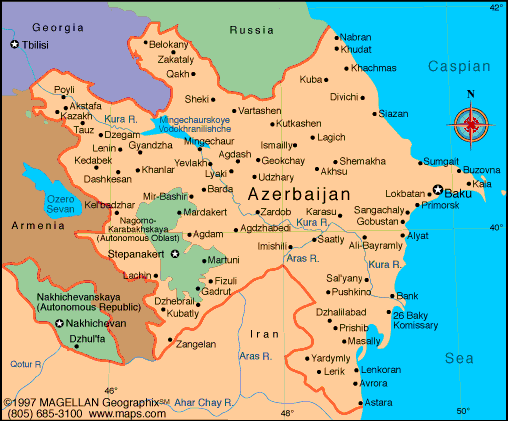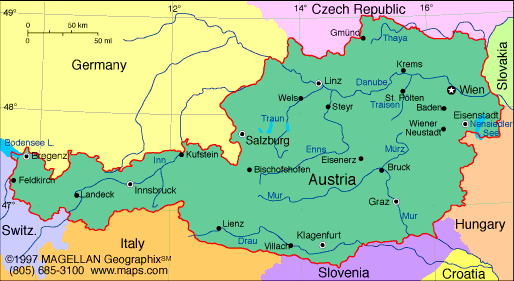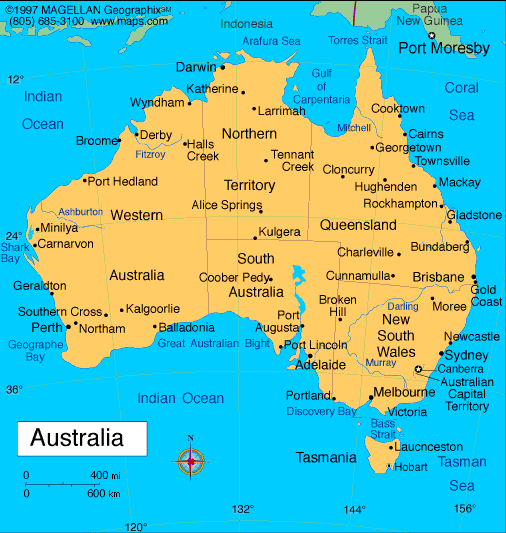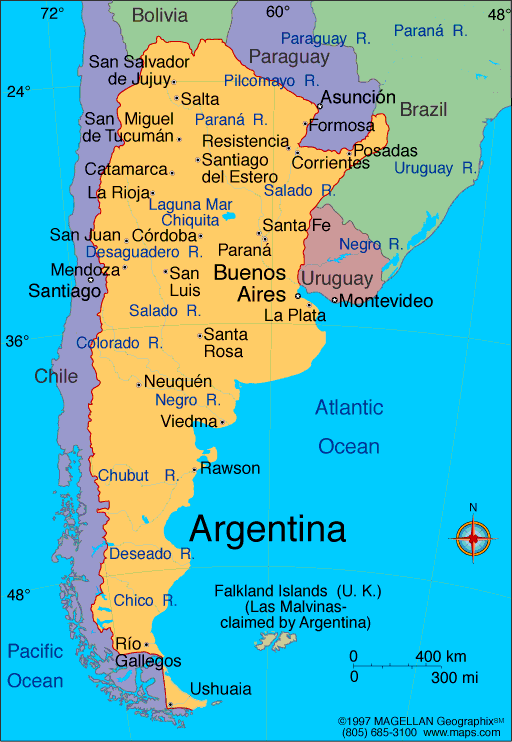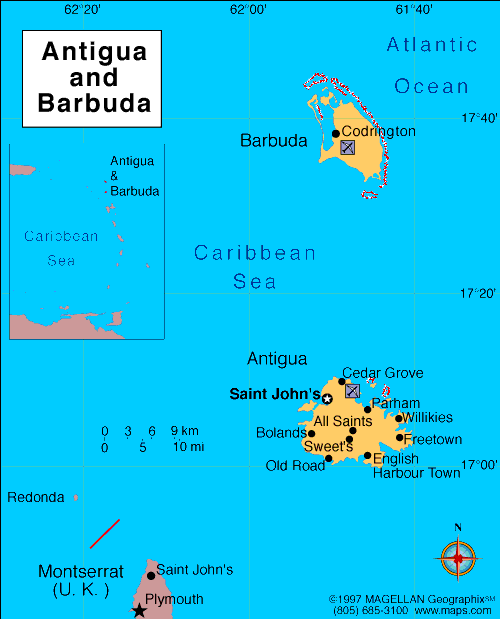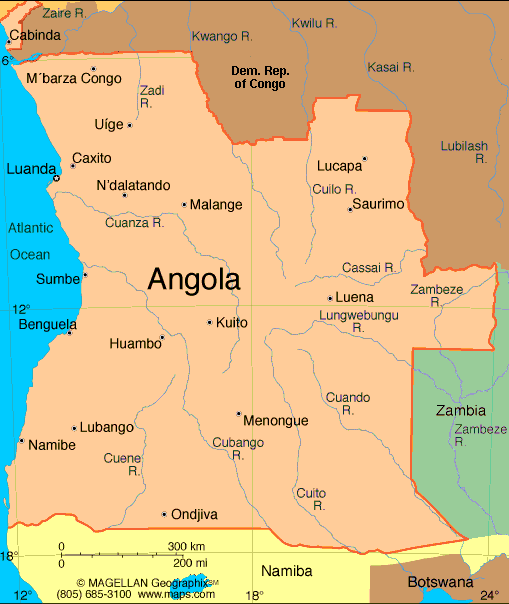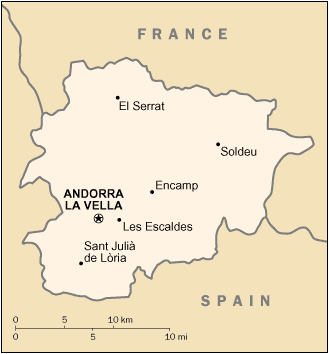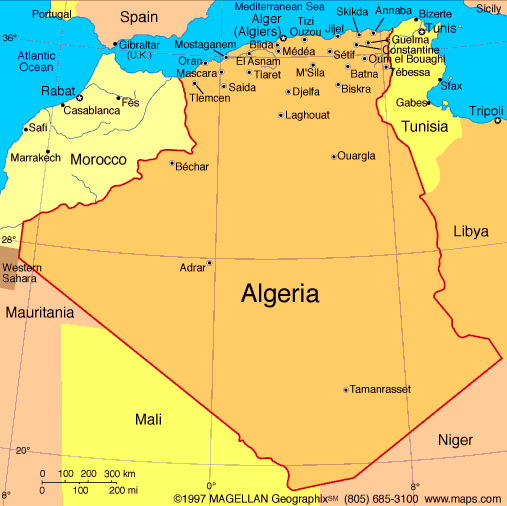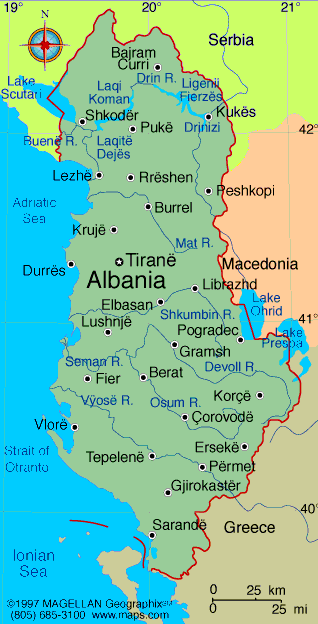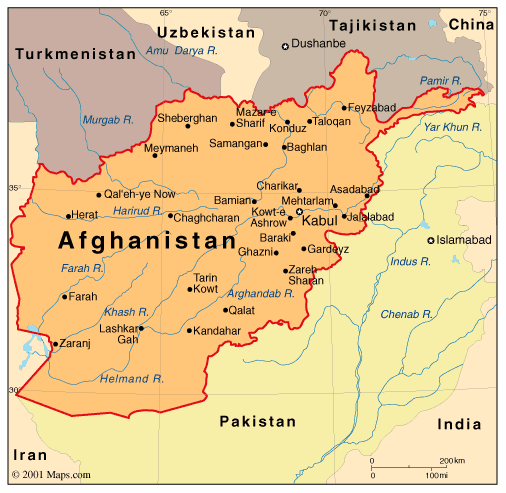
Afghanistan
Geography
Afghanistan, approximately the size of Texas, is bordered on the north by Turkmenistan, Uzbekistan, and Tajikistan, on the extreme northeast by China, on the east and south by Pakistan, and by Iran on the west. The country is split east to west by the Hindu Kush mountain range, rising in the east to heights of 24,000 ft (7,315 m). With the exception of the southwest, most of the country is covered by high snow-capped mountains and is traversed by deep valleys.
Government
In June 2002 a multiparty republic replaced an interim government that had been established in Dec. 2001, following the fall of the Islamic Taliban government.
History
Darius I and Alexander the Great were the first to use Afghanistan as the gateway to India. Islamic conquerors arrived in the 7th century, and Genghis Khan and Tamerlane followed in the 13th and 14th centuries.
In the 19th century, Afghanistan became a battleground in the rivalry between imperial Britain and czarist Russia for control of Central Asia. Three Anglo-Afghan wars (1839–1842, 1878–1880, and 1919) ended inconclusively. In 1893 Britain established an unofficial border, the Durand Line, separating Afghanistan from British India, and London granted full independence in 1919. Emir Amanullah founded an Afghan monarchy in 1926.
During the cold war, King Mohammed Zahir Shah developed close ties with the Soviet Union, accepting extensive economic assistance from Moscow. He was deposed in 1973 by his cousin Mohammed Daoud, who proclaimed a republic. Daoud was killed in a 1978 coup, and Noor Taraki took power, setting up a Marxist regime. He, in turn, was executed in Sept. 1979, and Hafizullah Amin became president. Amin was killed in Dec. 1979, as the Soviets launched a full-scale invasion of Afghanistan and installed Babrak Karmal as president.
The Soviets, and the Soviet-backed Afghan government, were met with fierce popular resistance. Guerrilla forces, calling themselves mujahideen, pledged a jihad, or holy war, to expel the invaders. Initially armed with outdated weapons, the mujahideen became a focus of U.S. cold war strategy against the Soviet Union, and with Pakistan's help, Washington began funneling sophisticated arms to the resistance. Moscow's troops were soon bogged down in a no-win conflict with determined Afghan fighters. In 1986 Karmal resigned, and was replaced by Mohammad Najibullah. In April 1988 the USSR, U.S., Afghanistan, and Pakistan signed accords calling for an end to outside aid to the warring factions. In return, a Soviet withdrawal took place in Feb. 1989, but the pro-Soviet government of President Najibullah was left in the capital, Kabul.
By mid-April 1992 Najibullah was ousted as Islamic rebels advanced on the capital. Almost immediately, the various rebel groups began fighting one another for control. Amid the chaos of competing factions, a group calling itself the Taliban—consisting of Islamic students—seized control of Kabul in Sept. 1996. It imposed harsh fundamentalist laws, including stoning for adultery and severing hands for theft. Women were prohibited from work and school, and they were required to cover themselves from head to foot in public. By fall 1998 the Taliban controlled about 90% of the country and, with its scorched-earth tactics and human rights abuses, had turned itself into an international pariah. Only three countries—Pakistan, Saudi Arabia, and the UAR—recognized the Taliban as Afghanistan's legitimate government.
On Aug. 20, 1998, U.S. cruise missiles struck a terrorist training complex in Afghanistan believed to have been financed by Osama bin Laden, a wealthy Islamic radical sheltered by the Taliban. The U.S. asked for the deportation of Bin Laden, whom it believed was involved in the bombing of the U.S. embassies in Kenya and Tanzania on Aug. 7, 1998. The UN also demanded the Taliban hand over Bin Laden for trial.
In Sept. 2001, legendary guerrilla leader Ahmed Shah Masoud was killed by suicide bombers, a seeming death knell for the anti-Taliban forces, a loosely connected group referred to as the Northern Alliance. Days later, terrorists attacked New York's World Trade Center towers and the Pentagon, and Bin Laden emerged as the primary suspect in the tragedy.
On Oct. 7, after the Taliban repeatedly and defiantly refused to turn over Bin Laden, the U.S. and its allies began daily air strikes against Afghan military installations and terrorist training camps. Five weeks later, with the help of U.S. air support, the Northern Alliance managed with breathtaking speed to take the key cities of Mazar-i-Sharif and Kabul, the capital. On Dec. 7, the Taliban regime collapsed entirely when its troops fled their last stronghold, Kandahar. However, al-Qaeda members and other mujahideen from various parts of the Islamic world who had earlier fought alongside the Taliban persisted in pockets of fierce resistance, forcing U.S. and allied troops to maintain a presence in Afghanistan. Osama bin Laden and Taliban leader Mullah Muhammad Omar remained at large.
In Dec. 2001, Hamid Karzai, a Pashtun (the dominant ethnic group in the country) and the leader of the powerful 500,000-strong Populzai clan, was named head of Afghanistan's interim government; in June 2002, he formally became president. The U.S. maintained about 12,000 troops to combat the remnants of the Taliban and al-Qaeda, and about 31 nations have also contributed NATO-led peacekeeping forces. But attacks on American-led forces have intensified since the war, and warlords continue to maintain tight regional control. In a highly aggressive and uncharacteristic move, Karzai attempted to rein in one of the most powerful warlords, Ismail Khan, by removing him from the governorship of Herat, a western province, in Sept. 2004. Violent protests followed Khan's ouster.
Afghanistan's loya jirga, or grand assembly, ratified a new constitution on Jan. 4, 2004. Low voter registration and the ongoing threat posed by insurgents prompted President Karzai to postpone elections scheduled for June 2004.
Sixteen candidates, including Karzai, were on the ballot in the Oct. 9, 2004, presidential election. Voter turnout was high, and violence was minimal. Karzai was declared the winner in November, taking 55.4% of the vote. He was inaugurated in December.
In May 2005, 17 people were killed during anti-American protests prompted by a report in Newsweek that American guards at the prison at Guantánamo Bay, Cuba, had desecrated the Koran. Although Newsweek, under intense pressure from the White House, retracted the story, FBI documents from 2002 and 2003, released in late May 2005, revealed that detainees at Guantánamo Bay complained that interrogators had abused the Koran. One complaint said guards flushed a Koran down a toilet.
The Taliban continued to attack U.S. troops throughout 2005, making it the deadliest year for U.S. troops since the war ended in 2001. The insurgents intensified their attacks over the summer—an attempt to disrupt September's parliamentary elections. In June, insurgents shot down a Chinook helicopter, killing eight Navy Seals and eight other Special Operations troops who were on a mission to rescue four Navy Seals.
U.S. and Afghan troops fought back, however, killing about 100 Taliban fighters and capturing dozens in July and August.
In September, voters chose from about 5,800 candidates in the country's first democratic parliamentary elections in more than 25 years. Turnout low, at about 50%. Results, released in October, report that at least half of the lower house is composed of Islamic conservatives and former jihad fighters. Women take 68 seats, or more than 25%. Members of the historic Parliament took the oath of office in December.
A group of more than 60 nations, including the U.S. and Britain, met in January and formulated the Afghanistan Compact, which aims to restore the country's economy and security, stem the drug trade, and secure a fully democratic government.
